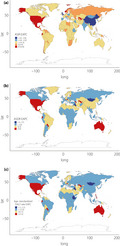- Record: found
- Abstract: found
- Article: found
Changing epidemiology of chronic kidney disease as a result of type 2 diabetes mellitus from 1990 to 2017: Estimates from Global Burden of Disease 2017

Read this article at
Abstract
Aims/Introduction
Type 2 diabetes mellitus has been a leading cause of chronic kidney disease (CKD), with a heterogeneous distribution worldwide. Optimal healthcare planning requires an understanding of how the burden of CKD as a result of type 2 diabetes mellitus has changed over time and geographic location, as well as the potential roles of sociodemographic, clinical and behavioral factors in these changes.
Materials and Methods
We used the Global Burden of Disease data from 1990 to 2017 at the global, regional and national levels to investigate changes in the incidence, death and disability‐adjusted life years of CKD as a result of type 2 diabetes mellitus, incorporating both epidemiological research and risk factor monitoring.
Results
The incident cases of CKD as a result of type 2 diabetes mellitus worldwide in 2017 had increased by 74% compared with 1990; total disability‐adjusted life years had increased by 113%, mainly attributable to population expansion and demographic transition. The Sociodemographic Index was significantly and negatively correlated with overall CKD as a result of type 2 diabetes mellitus burden. However, in 82 countries and territories, the burden was not alleviated in parallel with socioeconomic development.
Conclusions
CKD as a result of type 2 diabetes mellitus has been the main contributor to the increasing burden of CKD over the past several decades. We suggest a more pragmatic approach focusing on early diagnosis, primary care and adequate follow up to reduce mortality and the long‐term burden in low‐to‐middle Sociodemographic Index regions. Interventions should address high systolic blood pressure, as well as overweight and obesity problems, especially in high‐income regions.
Abstract
On a global scale, a modest decrease in the age‐standardized incidence rate of chronic kidney disease as a result of type 2 diabetes mellitus has been observed. Low‐ to middle‐income countries are suffering from a disproportionally higher burden of mortality rather than of morbidity compared with relatively more affluent counties. From 1990 to 2017, 82 of 195 countries failed to alleviate the burden of chronic kidney disease in patients with type 2 diabetes mellitus in parallel with sociodemographic development. Meanwhile, there are potential opportunities for countries across the entire development spectrum. High body mass index is accounting for an increasingly greater proportion of the age‐standardized disability‐adjusted life years rate globally.
Related collections
Most cited references39

- Record: found
- Abstract: found
- Article: found
Global, regional, and national incidence, prevalence, and years lived with disability for 354 diseases and injuries for 195 countries and territories, 1990–2017: a systematic analysis for the Global Burden of Disease Study 2017


- Record: found
- Abstract: found
- Article: found
